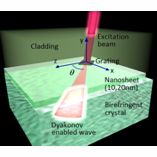May 27, 2014
In a study carried out by ICFO’s Nonlinear Optical Phenomena research group, led by Prof Lluís Torner, researchers were able to steer light guided by nanosheet films, without suffering any sort of losses. This was accomplished by the implementation of Dyakonov surface waves as opposed to surface plasmons. The scientific results of such experiment have been recently published in Nature Nanotechnology.
Guiding light at the nanoscale is usually accomplished using surface plasmons. However, plasmons propagating on the surface of a metal tend to show propagation losses and therefore, alternative solutions have been sought, one of them being a different type of surface excitation known as Dyakonov surface waves. Predicted in the late 80’s, these Dyaknov waves, which exist in lossless media, were not observed until recently. They exist when at least one of the two media forming the surface exhibits a suitable anisotropy of refractive indexes. These waves, which propagates only within a narrow directional range, they can be used to create very directive modes supported by ultrathin films that confine light efficiently within a film thickness well below the cutoff thickness required for standard waveguides.
In this study, Osamu Takayama, David Artigas and Lluis Torner have shown that 10 nm and 20 nm dielectric nanosheets of aluminium oxide clad between an anisotropic crystal and different liquids are capable of supporting Dyakonov-like modes. The direction of light propagation can be controlled by modulating the refractive index of the cladding. Being able to guide light in nanometre-thick films with no losses and high directionality makes Dyakonov wave modes attractive for planar photonic devices in schemes similar to those currently employing long-range plasmons.
Such discovery highlights the possibility of using these Dyanokov surface waves as a new platform for photonic devices based on guided surface waves, such as those used for sensing and routing applications.
Link to the Nonlinear Optical Phenomena research group led by Prof. Lluís Torner
Link to the paper

Dyakonov waves nano-guide light
Steering light in dielectric nanosheets in Nature Nanotechnology.

Dyakonov waves nano-guide light













